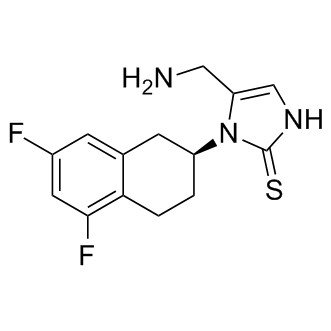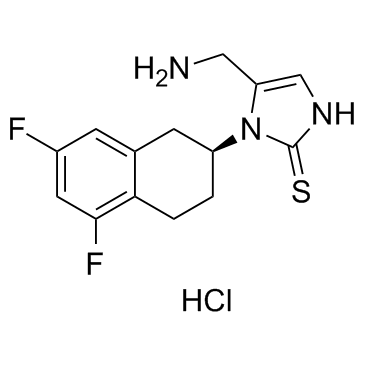Dopamine beta-hydroxylase
Norepinephrine (NE) is a neurotransmitter with essential roles in both the central and peripheral nervous systems. Dopamine beta-hydroxylase (DβH, dopamine β-monooxygenase; EC 1.14.17.1) is an enzyme required to synthesize NE from dopamine (DA) in noradrenergic cells of the locus coeruleus (LC) and post ganglionic sympathetic fibers, as well as in adrenal medulla chromaffin cells and epinephrine neurons. NE interacts with three major types of receptors each with different subtypes α1-like (α1a, b, d), α2-like(α2a, b, c, d) and β-like (β1−3). Human DβH has four domains: one Dopamine Beta-Monooxygenase Nterminal (DOMON) domain, two copper catalytic cores, and a tetramerization domain. The DβH promoter contains numerous regulatory elements, with the most well-studied being a glucocorticoid transcription enhancer and a cyclic AMP (cAMP) response element (CRE) that overlaps an AP1 site in the gene promoter (at position - 184bp relative to the transcription start site).
Other regulators include SP1, Phox2a/Arix, Egr1, three homeodomains, AP2 and AP4. The three homeobox motifs can bind Phox2a/Arix, which is vital for cell-specific DβH gene expression. The overlapping CRE/AP1 motif can bind CREB and also AP1 family members. The transcription factor early growth response protein 1 (Egr1) also inhibits DβH expression. With such a complex regulatory promoter in the DβH gene, novel variants in the promoter region of the gene may have a dramatic and widespread effect on noradrenergic signaling.
References
1.Gonzalez-Lopez E,et al. J Neurochem. 2019 Oct 15.
Other regulators include SP1, Phox2a/Arix, Egr1, three homeodomains, AP2 and AP4. The three homeobox motifs can bind Phox2a/Arix, which is vital for cell-specific DβH gene expression. The overlapping CRE/AP1 motif can bind CREB and also AP1 family members. The transcription factor early growth response protein 1 (Egr1) also inhibits DβH expression. With such a complex regulatory promoter in the DβH gene, novel variants in the promoter region of the gene may have a dramatic and widespread effect on noradrenergic signaling.
References
1.Gonzalez-Lopez E,et al. J Neurochem. 2019 Oct 15.
Metabolic Enzyme/Protease
11β-HSD(15)
15-PGDH(1)
ACC(10)
ACE(15)
AChE(47)
Adenylate Cyclase(12)
ALDH(14)
Aldose Reductase(5)
Aminopeptidase(19)
BACE(19)
Casein Kinase(51)
CAT(5)
Cathepsin(9)
CETP(13)
COMT(2)
CPG2(1)
CYPs(6)
Decarboxylase(3)
Dehydrogenase(131)
DGAT(4)
Dopamine beta-hydroxylase(2)
DPP(32)
Elastase(6)
FAAH(28)
Factor Xa(31)
Fatty Acid Synthase(17)
Ftase(2)
FXR(26)
Glucokinase(1)
GSNOR(2)
Guanylate Cyclase(13)
HMGCR(17)
IDH(7)
IDO(20)
IMPDH(2)
LDH(2)
LDL(8)
Lipase(17)
Lipid(12)
MAGL(6)
MAO(72)
MMP(78)
NAMPT(12)
Neprilysin(7)
Other Targets(10)
P450(112)
PAI-1(9)
Phosphatase(95)
Phospholipase(65)
PPAR(115)
Protein Phosphatase/PTP(6)
Renin(8)
Retinoid Receptor(37)
SCD(6)
Steroid Sulfatase (STS)(2)
Thioredoxin(1)
TPH(5)
Transferase(37)
Vitamin(44)
Xanthine Oxidase (XAO)(11)
Dopamine beta-hydroxylase
-
Nepicastat
产品货号 : M12642
cas no: 173997-05-2
Nepicastat (RS-25560-197, SYN-117) 是一种有效的、选择性的、口服活性的多巴胺-β-羟化酶 (DBH) 抑制剂,对牛和人 DBH 的 IC50 分别为 8.5 和 9.0 nM。
-
Nepicastat hydrochloride
产品货号 : M12599
cas no: 170151-24-3
Nepicastat (RS-25560-197, SYN-117) 是一种有效的、选择性的、口服活性的多巴胺-β-羟化酶 (DBH) 抑制剂,对牛和人 DBH 的 IC50 分别为 8.5 和 9.0 nM。



 021-51111890
021-51111890 购物车(0)
购物车(0)
 sales@molnova.cn
sales@molnova.cn






